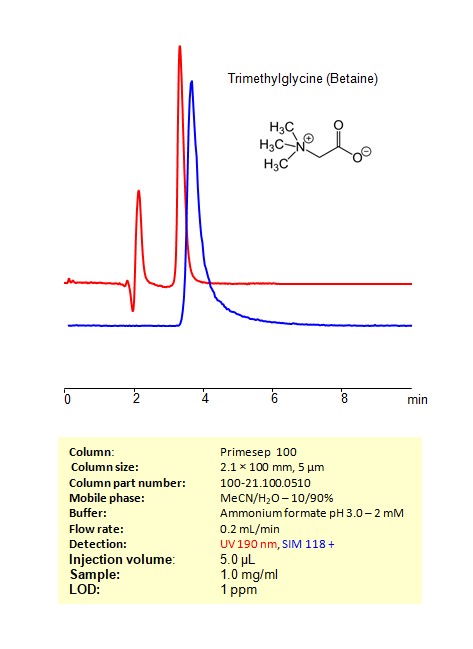HPLC Method for Analysis of Trimethylglycine (Betaine) on Primesep 100 by SIELC Technologies

High Performance Liquid Chromatography (HPLC) Method for Analysis of Trimethylglycine (Betaine)
Trimethylglycine, also known as betaine, is a compound derived from the amino acid glycine. It is found in various foods, including beets, spinach, whole grains, and seafood. Trimethylglycine has been studied for its potential health benefits, and it is commonly used as a dietary supplement.
Methylation Support: Trimethylglycine plays a role in a process called methylation, which is important for various biochemical reactions in the body. Methylation is involved in the synthesis of neurotransmitters, DNA, and proteins.Heart Health: Some studies suggest that trimethylglycine may have potential benefits for heart health. It is believed to help lower levels of homocysteine, an amino acid linked to an increased risk of heart disease when present in high concentrations.
Exercise Performance: There is some evidence suggesting that trimethylglycine supplementation may enhance exercise performance. It is thought to improve oxygen utilization and reduce fatigue during physical activity.
Liver Health: Trimethylglycine has been investigated for its potential to support liver health. It may help protect the liver from certain forms of damage.
Anti-Inflammatory Properties: Some studies propose that trimethylglycine may have anti-inflammatory effects, which could be beneficial in various health conditions.
Trimethylglycine can be retained and analyzed using a Primesep 100 mixed-mode stationary phase column. The analysis employs an isocratic method with a simple mobile phase consisting of water, acetonitrile (MeCN), and ammonium formate as a buffer. Detection is achieved using UV at 190 nm and SIM 118+
| Column | Primesep 100, 2.1 x 100 mm, 5 µm, 100 A, dual ended |
| Mobile Phase | MeCN/H2O – 10/90% |
| Buffer | Ammonium formate pH 3.0 – 2 mM |
| Flow Rate | 0.2 ml/min |
| Detection | UV 190 nm, SIM 188+ |
| Samples | 1 mg/mL |
| Injection volume | 1 µl |
| LOD* | 1 ppm |
| Class of Compounds | Quaternary ammonium |
| Analyzing Compounds | Trimethylglycine (Betaine) |
Application Column
Primesep 100
Column Diameter: 2.1 mm
Column Length: 100 mm
Particle Size: 5 µm
Pore Size: 100 A
Column options: dual ended





